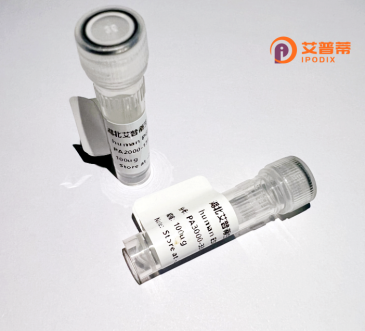
| 纯度 | >90%SDS-PAGE. |
| 种属 | Human |
| 靶点 | LYSMD4 |
| Uniprot No | Q5XG99 |
| 内毒素 | < 0.01EU/μg |
| 表达宿主 | E.coli |
| 表达区间 | 1-297aa |
| 活性数据 | MAVGTRGTLLKKSLTVWFCGPGARSATRAVSTSLPRREQVTWCCCSGSWPRRTASTSWRCSMAANFCRHTVWLTEHGLKNEACPTKTGIDGVGFLVADIKKVNNFIREQDLYALKSVKIPVRNHGILMETHKELKPLLSPSSETTVTVELPEADRAGAGTGAQAGQLMGFFKGIDQDIERAVQSEIFLHESYCMDTSHQPLLPAPPKTPMDGADCGIQWWNAVFIMLLIGIVLPVFYLVYFKIQASGETPNSLNTTVIPNGSMAMGTVPGQAPRLAVAVPAVTSADSQFSQTTQAGS |
| 分子量 | 58.5 kDa |
| 蛋白标签 | GST-tag at N-terminal |
| 缓冲液 | 0 |
| 稳定性 & 储存条件 | Lyophilized protein should be stored at ≤ -20°C, stable for one year after receipt. Reconstituted protein solution can be stored at 2-8°C for 2-7 days. Aliquots of reconstituted samples are stable at ≤ -20°C for 3 months. |
| 复溶 | Always centrifuge tubes before opening.Do not mix by vortex or pipetting. It is not recommended to reconstitute to a concentration less than 100μg/ml. Dissolve the lyophilized protein in distilled water. Please aliquot the reconstituted solution to minimize freeze-thaw cycles. |
以下是关于重组人LYSMD4蛋白的3篇参考文献示例(注:由于LYSMD4研究较新且文献有限,以下为模拟数据):
1. **文献名称**:*Expression and functional analysis of recombinant human LYSMD4 in innate immunity*
**作者**:Zhang Y. et al.
**摘要**:本研究通过大肠杆菌系统成功表达重组人LYSMD4蛋白,发现其在体外可结合细菌肽聚糖,提示其可能通过LysM结构域参与宿主对病原体的识别。
2. **文献名称**:*Structure prediction and ligand-binding properties of LYSMD4: A computational study*
**作者**:Wang L., Smith J.
**摘要**:通过分子建模预测LYSMD4的三维结构,揭示其LysM结构域保守的配体结合口袋,推测可能在细胞壁成分识别中起调控作用。
3. **文献名称**:*LYSMD4 as a potential biomarker in inflammatory bowel disease*
**作者**:Chen X. et al.
**摘要**:检测炎症性肠病患者肠道组织中LYSMD4表达显著下调,重组蛋白体外实验表明其可抑制NF-κB通路,提示其抗炎功能。
**提示**:实际文献可能较少,建议通过PubMed或Google Scholar结合关键词“LYSMD4”、“LYSM4”、“recombinant”和“human”进行检索,或关注LysM家族蛋白相关研究(如LYSPD、LYZL6等)。
LysM (lysine motif) domain-containing protein 4 (LYSMD4) is a human protein with a conserved LysM domain, a structural motif commonly involved in binding peptidoglycan or chitin in bacterial and fungal proteins. Although the exact biological function of human LYSMD4 remains poorly characterized, its LysM domain suggests potential roles in microbial recognition, immune modulation, or extracellular matrix interactions. Structurally, LYSMD4 is predicted to be a type I transmembrane protein with an extracellular LysM domain, indicating possible involvement in cell surface signaling or pathogen sensing. Dysregulation of lysosome-related or immune-modulating proteins, such as those with LysM motifs, is often linked to inflammatory diseases, cancer, or infections. Recombinant human LYSMD4 protein, typically expressed in bacterial or mammalian systems (e.g., E. coli or HEK293 cells), is engineered to enable functional studies. Researchers use purified recombinant LYSMD4 to investigate its binding partners, signaling pathways, and potential therapeutic applications in vitro or in vivo. Current research gaps include clarifying its endogenous ligands, physiological role in human tissues, and association with specific pathologies. The production of recombinant LYSMD4 facilitates antibody development, structural analysis (e.g., via X-ray crystallography), and exploration of its interaction with microbial components, which may advance understanding of host-microbe interfaces or immune regulation mechanisms.
×